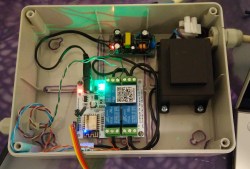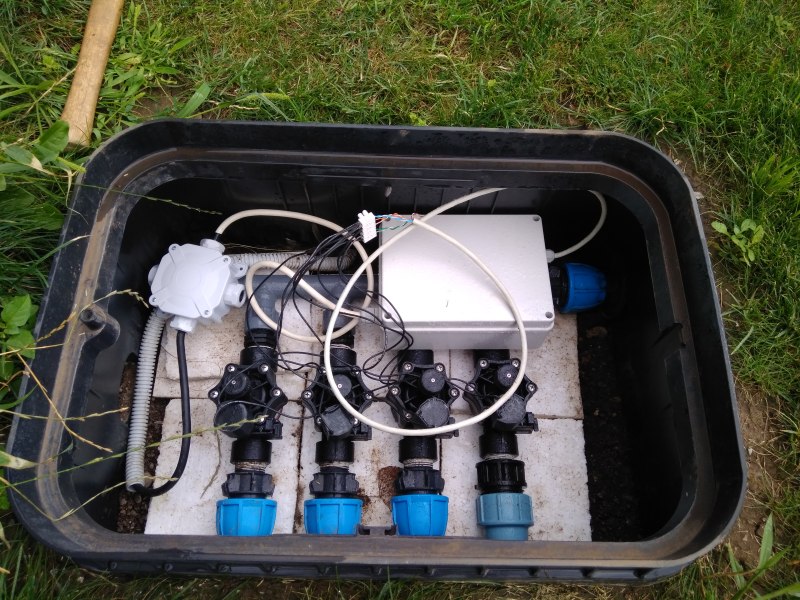What to do once you have a sprinkler system installed on your property: buy a sprinkler control system or make your own? The latter, obviously.
[danaman] was determined to hack together a cheap, IoT-enabled system but it wasn’t easy — taking the better part of a year to get working. Instead of starting right from scratch, he used the open-source Sustainable Irrigation Platform(SIP) control software — a Python sprinkler scheduler with some features [danman] was looking for(eg: it won’t activate if there’s rain in the forecast). Since he wasn’t running it with a Raspberry Pi as recommended, [danman] wrote a Python plugin that runs on his home server as a daemon which listens to TCP port 20000 for connections and then updates the relevant relays. Ok, software done; on to the relay controller box!
[danman]’s sprinkler system has four 12V AC valves that need wrangling, and no data cables, necessitating the  wireless setup. Initially, his control box contained a 240V AC to 12V AC 50VA transformer to power the valves, and a 240 AC to 5V DC power supply for the USB relay board and WiFi router. Once hooked up outside however, the router proved incapable of a reliable connection. [danman] ordered in and made a second attempt with an ESP8266 — writing a program in LUA to connect to the SIP scheduler, but now the relay’s serial connection was the unreliable link. Frustration!
wireless setup. Initially, his control box contained a 240V AC to 12V AC 50VA transformer to power the valves, and a 240 AC to 5V DC power supply for the USB relay board and WiFi router. Once hooked up outside however, the router proved incapable of a reliable connection. [danman] ordered in and made a second attempt with an ESP8266 — writing a program in LUA to connect to the SIP scheduler, but now the relay’s serial connection was the unreliable link. Frustration!
Opting for a more comprehensive solution, [danman] picked up a LinkNode R4 — a relay controller with integrated ESP8266 and controlled directly by the ESP’s GPIO pins — and reused his code from attempt number two, resulting in a smashing success!
[danman]’s code is available in his blog post you’ve been pondering a system like this for your own property. That is, unless you’re wanting something with a little more firepower.
















how about this? all the features without all the hassle: https://wiseorchard.com
there are lots of options for a IOT sprinkler controller…. but thats not what this whole site is about =)
plus all those commercial products had to start somewhere
Did anyone else read the title in their head in HOMERS voice, Damn you Simpsons 20 years of it.
…and instantly pictured him electrocuting himself when the sprinklers turned on! ????
Please do build and install! The neighborhood teens have been getting bored, and hacking it will keep them busy AND provide an educational exercise. You too would get an exercise trying to exorcise them! Everybody learns!
Feh, wireless…
Call me when you have a hoseless system like I do, it has a fusion reactor to power and light it too.
Help me out here: the sprinkler system needs a water connection, which usually comes from the house. The valves also need power to operate, again, a cable comes from the house to supply this. What, exactly, is the advantage of a wireless connection here? The author says there was only a power cable from the house, but when one goes to all the trouble of building an irrigation system, one usually connects a cable to the valves and routes it to where the controller is…was this not done? Seems like a major oversight. If a cable with the appropriate number of conductors wan’t provided, it would seem that replacing the existing cable with the correct one would be a lot easier.
Now, a wireless link between the controller and one’s home network, I can understand (though my controller is in the basement, right next to my internet hardware, so an RJ45 cable seems more reasonable).
I will help you out…
Rain = “hoseless system”
Sun = “fusion reactor to power and light it too”
Pics or it didn’t happen.
The 8266’s wifi performance is nothing short of miraculous. I’ve got a unit that’s effectively sealed up in a metal box outside and it can still get a solid link.
One who preserveres…
A waterless sprinkler system is easier to build.
With another crappy app which has no possibility to integrate into existing home automation…